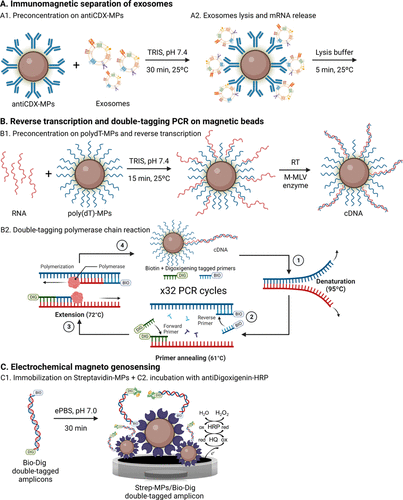Electrochemical Genosensing of Overexpressed GAPDH Transcripts in Breast Cancer Exosomes
Arnau Pallares-Rusiñol, Silio Lima Moura, Mercè Martí, and Maria Isabel Pividori*
https://doi.org/10.1021/acs.analchem.2c04773
Exosomes are receiving highlighted attention as new biomarkers for the detection of cancer since they are profusely released by tumor cells in different biological fluids. In this paper, the exosomes are preconcentrated from the serum by immunomagnetic separation (IMS) based on a CD326 receptor as a specific epithelial cancer-related biomarker and detected by glyceraldehyde-3-phosphate dehydrogenase (GAPDH) transcripts. Following the lysis of the captured exosomes, the released GAPDH transcripts are amplified by reverse transcription polymerase chain reaction (RT-PCR) with a double-tagging set of primers on poly(dT)-modified-MPs to increase the sensitivity. The double-tagged amplicon is then quantified by electrochemical genosensing. The IMS/double-tagging RT-PCR/electrochemical genosensing approach is first demonstrated for the sensitive detection of exosomes derived from MCF7 breast cancer cells and compared with CTCs in terms of the analytical performance, showing an LOD of 4 × 102 exosomes μL–1. The genosensor was applied to human samples by immunocapturing the exosomes directly from serum from breast cancer patients and showed a higher electrochemical signal (3.3-fold, p < 0.05), when compared with healthy controls, suggesting an overexpression of GAPDH on serum-derived exosomes from breast cancer patients. The detection of GAPDH transcripts is performed from only 1.0 mL of human serum using specific magnetic particles, improving the analytical simplification and avoiding ultracentrifugation steps, demonstrating to be a promising strategy for minimal invasive liquid biopsy.

